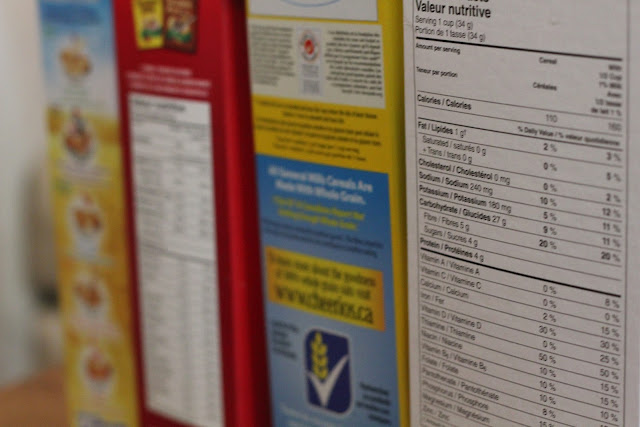One of the trickiest aisles to navigate in the supermarket is the cereal aisle. This is because, like yogurt, cereal has a "health halo", which is food industry-speak for the aura of health that sounds a particular food (whether it deserves it or not.) People often think it's a lot healthier than it is.
Another reason it's tricky is because it's full of spit and polish - beautiful, inviting colours, pretty fonts, photos of luscious berries tumbling into those wholesome flakes. But when you turn the box around, what you see is that most cereals are made up of wheat, rice, corn and sugar, followed by a long list of non-pronounceable ingredients.
So how do you navigate this minefield of good and not-so-good choices?
Here are some guidelines::
Look for cereals with 4 grams (1 teaspoon) of sugar or less
I know: you know enough to stay away from sugary cereals. Let me just say this - it is not just the blatant Choco-Caramel Rings and the Cupcake Crispies that you need to watch out for. Many of the more wholesome sounding cereals aren't exactly good choices either, as this video from the Yale Rudd Center for Food Policy and Obesity points out. To stay on the safe side, look for cereals with 4 grams (1 teaspoon) of sugar or less per serving.Look for cereals with at least 3-5 grams of fibre
The Dietitians of Canada recommend 25 - 38 grams of fibre per day to help lower cholesterol, manage blood sugar levels and help keep you regular. I know - that is a WHACK of fibre and most of us don't even get half of that. Breakfast is an easy way to get some. (Note - if you don't like high fibre cereal, sprinkle 1-2 teaspoons of bran, chia seeds or flax seeds on your regular cereal. It's a great way to sneak in fibre)Ignore the 'low fat' claim
So many cereals carry the claims 'low fat', 'fat free' or 'saturated fat free' these days. That's a good thing, right? After all, you want to fit into that red dress!Guess what? Almost every plain cereal is low in fat. That's because it's made up mostly of flour or rice or corn, which are low in fat. So choosing a cereal because it is low in fat is like choosing a cheese because it is made with milk. Companies only market it that way because they know that will make people buy it.
Will it help you lose weight? Well, if you eat the serving specified and it fills you up and keeps you going until lunch, then it might. The problem is that most cereals are highly processed and made from white flour or white rice or corn, which means they don't actually fill you up. You are basically having a bowl of white rice with some sugar on it. And because it doesn't fill you up, you end up having a second (or in my case third) bowl, or you give in to that muffin at 10 am. So much for the red dress.
Better, I say, to have some fat - good fat, of course, which will keep you full and going until lunch. Put some nuts on that high-fibre, low sugar cereal and enjoy.
And as always, follow the three simple rules: never believe the front of the box, the ingredient label never lies, and read the nutritional panel.
I know, I know: high fibre, low sugar cereal doesn't exactly scream hedonism. I hear you. In fact, I love cereal - anything that is carb-laden practically has my name tatooed on it. So I indulge occasionally. But I see those overly sweet, 'diet' cereals that I love for what they really are: dessert, not breakfast. Eating a bowl of sweetened, flaky cereal to get me going in the morning may not work, but having a bowl instead of the butter-rich cookies I was going to have for dessert is a good trade off to me.
You can read my other Supermarket Survival Guide here:
Supermarket Survival Guide: Yogurt
Find the best and worst choices in the supermarket here:
Top 5 Hidden Gems in the Supermarket
Healthy Pretenders: the Most Overrated foods in the Supermarket
Read my other articles on navigating the supermarket here.

No comments:
Post a Comment